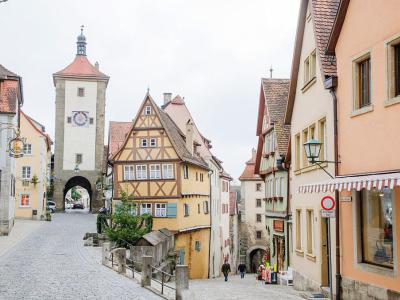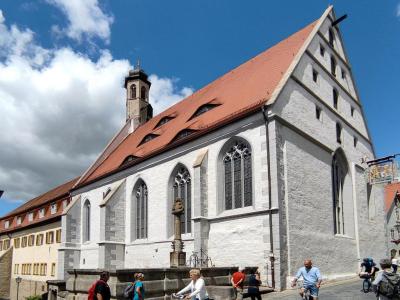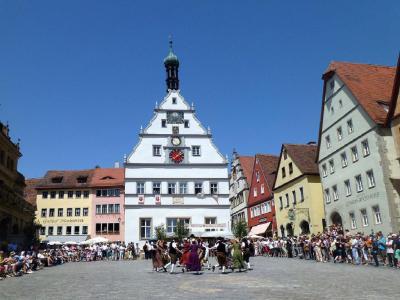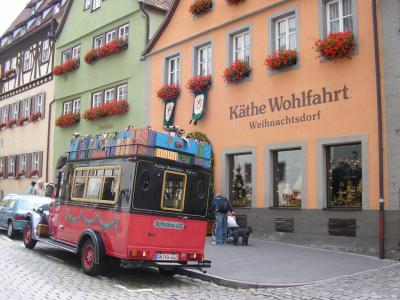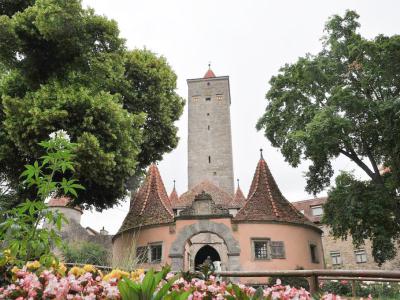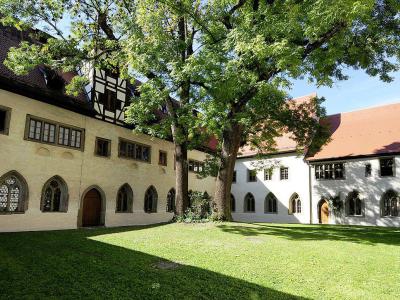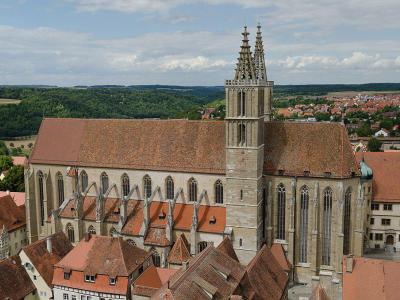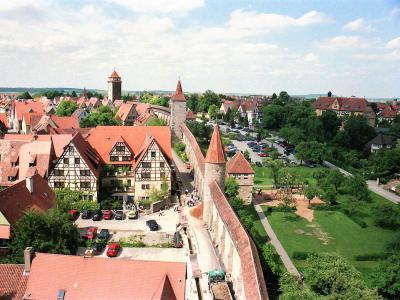
Rothenburg Introduction Walking Tour (Self Guided), Rothenburg
Picturesquely positioned on the steep banks of the River Tauber, the Bavarian town of Rothenburg offers a glimpse into Germany's medieval past.
The town's full name – Rothenburg ob der Tauber – translates to “Red castle above the Tauber”. This moniker stems from the German words “rot” (which means red) and “burg” (castle) and refers to its location (on an elevated plateau overlooking the river). The houses' red-roofed appearance contributed to the name just as well. Alternatively, they say, it could have been related to the retting process (“rotten” in German) that was once used for linen production here.
Rothenburg's history spans over a millennium. In 950, the Count of Comburg-Rothenburg constructed a weir system in the area of today's Castle Garden. In 1070, Rothenburg Castle was built atop a mountain by the River Tauber, belonging to the counts of Comburg-Rothenburg. In 1142, their successor Konrad von Hohenstaufen, later King Konrad III, built Stauffer Castle, alongside which, in 1170, the town of Rothenburg was established.
In 1803, Rothenburg became part of Bavaria. During the 19th century, it captured the hearts of numerous artists, which in turn spurred the first wave of tourists.
In the 20th century, Rothenburg held significance for Nazi ideologists, embodying their vision of the quintessential German town. The Nazis organized here day trips and expelled Jewish citizens in 1938. During World War II, Rothenburg endured bombing but maintained its historic core.
In 1945, American troops occupied Rothenburg. The town's resilience led to its post-war restoration, blending original medieval structures with rebuilt facades. Today, Rothenburg stands as a living testament to history's endurance, preserving its past while inviting visitors to explore its unique charm.
Among the fascinating points of interest here are the 13th-century Town Hall (Rathaus); the 14th-century Councilmen Inn, with its old clock and mechanical figures; and several fine old-time churches like St. Jacob's and St. Johannis'. Half-timbered houses with their characteristic steeply pitched roofs line the narrow cobblestone streets, some housing museums recounting Rothenburg's long and eventful history, such as the Medieval Crime Museum, the German Christmas Museum, and the Rothenburg Museum.
With its well-preserved, centuries-old architecture and charming ambiance, Rothenburg can easily immerse visitors in the beauty and culture of medieval Germany. As you stroll through its lanes, you realize that the chief attraction of Rothenburg is the town itself. Come to explore this living canvas of medieval beauty painted with time's brushstrokes and feel history not as a distant memory but a tangible reality.
The town's full name – Rothenburg ob der Tauber – translates to “Red castle above the Tauber”. This moniker stems from the German words “rot” (which means red) and “burg” (castle) and refers to its location (on an elevated plateau overlooking the river). The houses' red-roofed appearance contributed to the name just as well. Alternatively, they say, it could have been related to the retting process (“rotten” in German) that was once used for linen production here.
Rothenburg's history spans over a millennium. In 950, the Count of Comburg-Rothenburg constructed a weir system in the area of today's Castle Garden. In 1070, Rothenburg Castle was built atop a mountain by the River Tauber, belonging to the counts of Comburg-Rothenburg. In 1142, their successor Konrad von Hohenstaufen, later King Konrad III, built Stauffer Castle, alongside which, in 1170, the town of Rothenburg was established.
In 1803, Rothenburg became part of Bavaria. During the 19th century, it captured the hearts of numerous artists, which in turn spurred the first wave of tourists.
In the 20th century, Rothenburg held significance for Nazi ideologists, embodying their vision of the quintessential German town. The Nazis organized here day trips and expelled Jewish citizens in 1938. During World War II, Rothenburg endured bombing but maintained its historic core.
In 1945, American troops occupied Rothenburg. The town's resilience led to its post-war restoration, blending original medieval structures with rebuilt facades. Today, Rothenburg stands as a living testament to history's endurance, preserving its past while inviting visitors to explore its unique charm.
Among the fascinating points of interest here are the 13th-century Town Hall (Rathaus); the 14th-century Councilmen Inn, with its old clock and mechanical figures; and several fine old-time churches like St. Jacob's and St. Johannis'. Half-timbered houses with their characteristic steeply pitched roofs line the narrow cobblestone streets, some housing museums recounting Rothenburg's long and eventful history, such as the Medieval Crime Museum, the German Christmas Museum, and the Rothenburg Museum.
With its well-preserved, centuries-old architecture and charming ambiance, Rothenburg can easily immerse visitors in the beauty and culture of medieval Germany. As you stroll through its lanes, you realize that the chief attraction of Rothenburg is the town itself. Come to explore this living canvas of medieval beauty painted with time's brushstrokes and feel history not as a distant memory but a tangible reality.
How it works: Download the app "GPSmyCity: Walks in 1K+ Cities" from Apple App Store or Google Play Store to your mobile phone or tablet. The app turns your mobile device into a personal tour guide and its built-in GPS navigation functions guide you from one tour stop to next. The app works offline, so no data plan is needed when traveling abroad.
Rothenburg Introduction Walking Tour Map
Guide Name: Rothenburg Introduction Walking Tour
Guide Location: Germany » Rothenburg (See other walking tours in Rothenburg)
Guide Type: Self-guided Walking Tour (Sightseeing)
# of Attractions: 13
Tour Duration: 2 Hour(s)
Travel Distance: 1.8 Km or 1.1 Miles
Author: nataly
Sight(s) Featured in This Guide:
Guide Location: Germany » Rothenburg (See other walking tours in Rothenburg)
Guide Type: Self-guided Walking Tour (Sightseeing)
# of Attractions: 13
Tour Duration: 2 Hour(s)
Travel Distance: 1.8 Km or 1.1 Miles
Author: nataly
Sight(s) Featured in This Guide:
- Siebersturm (Sifter Makers’ Tower)
- Little Square
- Medieval Crime Museum
- St. Johannis Church
- Town Hall
- Councelmen Inn
- Jagstheimer House (Marien Pharmacy)
- German Christmas Museum
- Castle Garden
- Rothenburg Museum
- City Church of St. Jakob
- Markus Tower and Beadle House
- Town Walls
1) Siebersturm (Sifter Makers’ Tower)
Sifter Makers’ Tower holds a significant place in the history and architecture of Rothenburg. Constructed around 1385, this impressive tower served as a prominent entrance to the town for nearly 150 years. However, with the building of the Spital Bastion in the sixteenth century, its role as the main gateway was eventually overshadowed.
Approaching Siebers Tower, visitors are greeted with an archway that leads them into the heart of Rothenburg. This archway marks the entrance to Das Plonlein, a picturesque square renowned for its charming half-timbered houses. The tower itself stands proudly, its sturdy stone walls and imposing structure reflecting the architectural style of its time.
Beyond the archway lies the opportunity to access the town wall, one of Rothenburg's most iconic features. Positioned just south of Siebers Tower, this entry point allows visitors to step onto the ancient fortifications and experience a breathtaking view of the town and its surroundings. The sight is sure to captivate anyone, as the walls encircle Rothenburg with an aura of history and enchantment.
As one walks through the archway, an immediate sense of awe and wonder sets in. The feeling of stepping into a bygone era becomes tangible, as the cobblestone streets and preserved medieval architecture transport visitors back in time. Siebers Tower, with its commanding presence and rich historical significance, plays an integral part in creating this immersive experience.
Approaching Siebers Tower, visitors are greeted with an archway that leads them into the heart of Rothenburg. This archway marks the entrance to Das Plonlein, a picturesque square renowned for its charming half-timbered houses. The tower itself stands proudly, its sturdy stone walls and imposing structure reflecting the architectural style of its time.
Beyond the archway lies the opportunity to access the town wall, one of Rothenburg's most iconic features. Positioned just south of Siebers Tower, this entry point allows visitors to step onto the ancient fortifications and experience a breathtaking view of the town and its surroundings. The sight is sure to captivate anyone, as the walls encircle Rothenburg with an aura of history and enchantment.
As one walks through the archway, an immediate sense of awe and wonder sets in. The feeling of stepping into a bygone era becomes tangible, as the cobblestone streets and preserved medieval architecture transport visitors back in time. Siebers Tower, with its commanding presence and rich historical significance, plays an integral part in creating this immersive experience.
2) Little Square
Little Square is a charming and picturesque spot that holds historical significance and captures the essence of romantic beauty. This unique location is situated at a fork in the road and was once home to a fish emporium.
The scenic beauty of Little Square makes it a popular choice for postcard designs and a favorite spot for capturing memorable photographs. Surrounded by enchanting half-timbered houses and offering a stunning vista of the White Tower, it provides visitors with a nostalgic experience and transports them to a bygone era.
The name "Little Square" (german "Plönlein") has its origins in the Latin word "Planum," which means "flat place." This name perfectly suits the location, as it sits at a level area where the roads diverge. The gate towers, Kobolzellertor and Sieberstor, were constructed during the city's expansion in 1204.
The Kobolzeller Tower served as a guardian of the city entrance from the Tauber Valley many years ago. On the other hand, the Sieber Tower, fortified with rough quarried stone, acted as the southern portal during the 14th century and played a crucial role in including the hospital district within the city's fortifications.
Little Square, with its rich history, architectural splendor, and idyllic surroundings, encapsulates the essence of Rothenburg ob der Tauber. It offers a delightful ensemble of sights and is a must-visit location for those seeking to immerse themselves in the beauty and charm of this medieval town. Whether one admires the captivating views, explores the historic gate towers, or simply takes a leisurely stroll through its quaint streets, Little Square promises an unforgettable experience filled with romance and nostalgia.
The scenic beauty of Little Square makes it a popular choice for postcard designs and a favorite spot for capturing memorable photographs. Surrounded by enchanting half-timbered houses and offering a stunning vista of the White Tower, it provides visitors with a nostalgic experience and transports them to a bygone era.
The name "Little Square" (german "Plönlein") has its origins in the Latin word "Planum," which means "flat place." This name perfectly suits the location, as it sits at a level area where the roads diverge. The gate towers, Kobolzellertor and Sieberstor, were constructed during the city's expansion in 1204.
The Kobolzeller Tower served as a guardian of the city entrance from the Tauber Valley many years ago. On the other hand, the Sieber Tower, fortified with rough quarried stone, acted as the southern portal during the 14th century and played a crucial role in including the hospital district within the city's fortifications.
Little Square, with its rich history, architectural splendor, and idyllic surroundings, encapsulates the essence of Rothenburg ob der Tauber. It offers a delightful ensemble of sights and is a must-visit location for those seeking to immerse themselves in the beauty and charm of this medieval town. Whether one admires the captivating views, explores the historic gate towers, or simply takes a leisurely stroll through its quaint streets, Little Square promises an unforgettable experience filled with romance and nostalgia.
3) Medieval Crime Museum (must see)
The Medieval Crime Museum delves into the legal affairs and criminal history of Europe. Established in 1977 within the former Johanniter Commandery, the museum houses an impressive collection of over 50,000 exhibits spanning more than 1,000 years, with a focus on the Middle Ages.
Originally a private collection, it expanded over the years under various owners, including the artist couple Ernst Paul Hinckeldey and Marta Hinckeldey-Wittke. The museum moved to its current location in 1977, allowing for further expansion and establishing itself as a comprehensive legal museum.
The collection was entrusted to a foundation in 1993, supporting both the operation of the museum and scientific research. The museum serves as a testament to historical legal systems and offers visitors an engaging and educational experience within the historical setting of the former Johanniter Commandery.
Originally a private collection, it expanded over the years under various owners, including the artist couple Ernst Paul Hinckeldey and Marta Hinckeldey-Wittke. The museum moved to its current location in 1977, allowing for further expansion and establishing itself as a comprehensive legal museum.
The collection was entrusted to a foundation in 1993, supporting both the operation of the museum and scientific research. The museum serves as a testament to historical legal systems and offers visitors an engaging and educational experience within the historical setting of the former Johanniter Commandery.
4) St. Johannis Church
Saint Johannis Church has a rich history and architectural significance. Originally serving as the former monastery church of the Johanniter, it has been the Roman Catholic parish church of Saint Johannis since 1803. The church is listed as a monument in the Bavarian list of monuments. The parish falls under the Deanery of Ansbach in the Archdiocese of Bamberg.
Constructed between 1390 and 1410, Saint Johannis Church is a three-nave hall church with a steep gabled roof. The design of the church is credited to Hans von Burghausen. A notable feature of the church's exterior is the hexagonal turret situated in front of the west gable. Topped with an onion dome, the turret adds a distinctive element to the church's architecture. Adorning the outer wall of the north side are stone statues of John the Baptist and Saint Christopher, adding a touch of artistic flair to the church's facade.
Inside the church, visitors are greeted by a wooden beam ceiling supported by four columns, covering the interior of the church. While the original church furnishings have undergone significant reduction over the years, one notable piece that has been preserved is the crescent moon Madonna. Created around 1730/40, this Madonna statue stands as a testament to the church's historical significance.
The church's organ, built by GF Steinmeyer & Co. in 1885, is another noteworthy element. The organ boasts 23 registers, 2 manuals, and a pedal. In 1993, the organ was expanded with the addition of 3 registers, further enhancing its musical capabilities.
Constructed between 1390 and 1410, Saint Johannis Church is a three-nave hall church with a steep gabled roof. The design of the church is credited to Hans von Burghausen. A notable feature of the church's exterior is the hexagonal turret situated in front of the west gable. Topped with an onion dome, the turret adds a distinctive element to the church's architecture. Adorning the outer wall of the north side are stone statues of John the Baptist and Saint Christopher, adding a touch of artistic flair to the church's facade.
Inside the church, visitors are greeted by a wooden beam ceiling supported by four columns, covering the interior of the church. While the original church furnishings have undergone significant reduction over the years, one notable piece that has been preserved is the crescent moon Madonna. Created around 1730/40, this Madonna statue stands as a testament to the church's historical significance.
The church's organ, built by GF Steinmeyer & Co. in 1885, is another noteworthy element. The organ boasts 23 registers, 2 manuals, and a pedal. In 1993, the organ was expanded with the addition of 3 registers, further enhancing its musical capabilities.
5) Town Hall
The Rothenburg Town Hall is a captivating historical building. As one of the town's most remarkable landmarks, it attracts numerous tourists seeking to immerse themselves in its rich history and architectural splendor.
Constructed in the 13th century, the Town Hall has undergone various renovations and expansions throughout the centuries. Its most prominent feature is its striking clock tower, which stands tall and dominates the town's skyline. The building's Gothic-style architecture is truly captivating, characterized by intricate stonework and ornate decorative elements.
Upon entering the Town Hall, visitors are greeted with a plethora of breathtaking sights. The grand staircase, adorned with murals and frescoes, is a sight to behold. As you ascend, the beauty and craftsmanship of the council chambers become evident, with their intricate woodwork and exquisite furnishings. The chambers also house a collection of historical artifacts and documents, including old maps, portraits of significant town figures, and other valuable relics that offer a glimpse into Rothenburg ob der Tauber's vibrant past.
One of the Town Hall's most fascinating aspects is its tower, standing at an impressive height of over 60 meters. For a small fee, visitors can climb to the top and relish in the panoramic views of the well-preserved medieval center, surrounded by fields and forests. From this vantage point, the town's timeless beauty unfolds, providing a captivating perspective of the architectural wonders and natural landscapes that grace Rothenburg ob der Tauber.
Furthermore, the Town Hall serves as a hub for important cultural events throughout the year, making it a vibrant center of activity. Concerts, exhibitions, and festivals all find a home within its walls, offering both locals and visitors the opportunity to celebrate and appreciate the town's rich cultural heritage.
Constructed in the 13th century, the Town Hall has undergone various renovations and expansions throughout the centuries. Its most prominent feature is its striking clock tower, which stands tall and dominates the town's skyline. The building's Gothic-style architecture is truly captivating, characterized by intricate stonework and ornate decorative elements.
Upon entering the Town Hall, visitors are greeted with a plethora of breathtaking sights. The grand staircase, adorned with murals and frescoes, is a sight to behold. As you ascend, the beauty and craftsmanship of the council chambers become evident, with their intricate woodwork and exquisite furnishings. The chambers also house a collection of historical artifacts and documents, including old maps, portraits of significant town figures, and other valuable relics that offer a glimpse into Rothenburg ob der Tauber's vibrant past.
One of the Town Hall's most fascinating aspects is its tower, standing at an impressive height of over 60 meters. For a small fee, visitors can climb to the top and relish in the panoramic views of the well-preserved medieval center, surrounded by fields and forests. From this vantage point, the town's timeless beauty unfolds, providing a captivating perspective of the architectural wonders and natural landscapes that grace Rothenburg ob der Tauber.
Furthermore, the Town Hall serves as a hub for important cultural events throughout the year, making it a vibrant center of activity. Concerts, exhibitions, and festivals all find a home within its walls, offering both locals and visitors the opportunity to celebrate and appreciate the town's rich cultural heritage.
6) Councelmen Inn
The Councelmen Inn is a renowned and captivating building that holds significant historical and cultural value. Originally serving as an inn exclusively for councilmen, it provided a secluded space where they could indulge in their favorite beverages, be it wine or beer, away from the common folk who were forbidden from entering.
The Ratstrinkstube stands as a remarkable architectural gem that catches the eye of visitors. Every hour, between 10 a.m. and 10 p.m., eager crowds gather in anticipation, eagerly awaiting the moment when the shutters of the building open. It is an eagerly anticipated spectacle for tourists and locals alike. The gable of the facade, which is a popular subject for photographs, features three different clocks and the coat of arms of the imperial city. The largest and primary clock, installed in 1683, continues to accurately display the time to this day. Above it is a date display, and further above, an impressive sundial adorned with the signs of the zodiac, which dates back to 1768.
However, the main highlight of the Ratstrinkstube is the art clock that depicts a crucial event from the history of Rothenburg ob der Tauber. In 1631, during the Thirty Years' War, a significant incident known as the "master drink" took place at this very location. The Catholic troops, led by their commander Count Tilly, threatened to ransack the Protestant town of Rothenburg.
On a whim, Tilly proposed a challenge to the city's mayor: if he could consume a massive 3.25 liter tankard of Franconian wine in a single gulp, he would spare Rothenburg. Accepting the high-stakes challenge, the mayor successfully completed the feat, thus saving his beloved city. In 1910, statues of the two key figures involved in this event were integrated into the front of the Ratstrinkstube, and since then, they come to life every hour, reenacting this memorable episode.
The Ratstrinkstube stands as a remarkable architectural gem that catches the eye of visitors. Every hour, between 10 a.m. and 10 p.m., eager crowds gather in anticipation, eagerly awaiting the moment when the shutters of the building open. It is an eagerly anticipated spectacle for tourists and locals alike. The gable of the facade, which is a popular subject for photographs, features three different clocks and the coat of arms of the imperial city. The largest and primary clock, installed in 1683, continues to accurately display the time to this day. Above it is a date display, and further above, an impressive sundial adorned with the signs of the zodiac, which dates back to 1768.
However, the main highlight of the Ratstrinkstube is the art clock that depicts a crucial event from the history of Rothenburg ob der Tauber. In 1631, during the Thirty Years' War, a significant incident known as the "master drink" took place at this very location. The Catholic troops, led by their commander Count Tilly, threatened to ransack the Protestant town of Rothenburg.
On a whim, Tilly proposed a challenge to the city's mayor: if he could consume a massive 3.25 liter tankard of Franconian wine in a single gulp, he would spare Rothenburg. Accepting the high-stakes challenge, the mayor successfully completed the feat, thus saving his beloved city. In 1910, statues of the two key figures involved in this event were integrated into the front of the Ratstrinkstube, and since then, they come to life every hour, reenacting this memorable episode.
7) Jagstheimer House (Marien Pharmacy)
Jagstheimer House, also known as the Marien Pharmacy, is a historic building with a rich and intriguing past. Its foundation walls and cellar not only symbolize its physical connection to the earth but also serve as a reminder of its deep-rooted history. The house was originally constructed in 1448 by Mayor Jagstheimer, and it stands in close proximity to the Fleisch- und Tanzhaus in Rothenburg.
One of the notable events in the history of Jagstheimer House was the visit of Emperor Maximilian I. The beautiful patrician house, distinguished by its magnificent facade, had the honor of hosting this esteemed guest. The presence of such a prominent figure further adds to the historical significance of the building.
Since 1812, Jagstheimer House has been operating as a pharmacy, serving the community of Rothenburg and its visitors. The pharmacy has remained in the same family for five generations, a testament to its enduring commitment to providing essential health services to the town. Throughout the years, Jagstheimer House has played a vital role in promoting and maintaining the well-being of the people by supplying medicines, remedies, and various health-related products.
One of the notable events in the history of Jagstheimer House was the visit of Emperor Maximilian I. The beautiful patrician house, distinguished by its magnificent facade, had the honor of hosting this esteemed guest. The presence of such a prominent figure further adds to the historical significance of the building.
Since 1812, Jagstheimer House has been operating as a pharmacy, serving the community of Rothenburg and its visitors. The pharmacy has remained in the same family for five generations, a testament to its enduring commitment to providing essential health services to the town. Throughout the years, Jagstheimer House has played a vital role in promoting and maintaining the well-being of the people by supplying medicines, remedies, and various health-related products.
8) German Christmas Museum
The German Christmas Museum is a unique institution. Spanning approximately 250 square meters, the museum offers a deep dive into the evolution of German Christmas traditions from the Middle Ages to about 1950. It displays an array of enchanting items that have colored the German Yuletide landscape throughout history, ranging from ornaments and decorations to toys and artifacts.
The collection boasts remarkable items crafted from a variety of materials, such as glass, cotton, wool, paper, wax, and metals, as well as Dresden cardboard. These meticulously curated pieces represent the diversity and creativity that underpins German Christmas craftsmanship.
The museum further includes specific exhibition areas showcasing collections of Santa Clauses, Christmas angels, nutcrackers, tree stands, paper Nativity scenes, lamps, Advent calendars, and Erzgebirge pyramids. One of the primary highlights is a striking 5,000-piece display of Christmas tree ornaments, a notable private Austrian collection that has been generously loaned to the museum. In addition, a large private collection of nutcrackers significantly enriches the exhibition.
Visitors to the German Christmas Museum are first introduced to German Christmas traditions and the history of the Christmas tree, a German invention. Thereafter, they embark on a journey through several rooms packed with captivating exhibits.
This pioneering museum is an extension of the Käthe Wohlfahrt brand and attracts hundreds of thousands of visitors, not only from its home in Rothenburg, but also from subsidiaries in Oberammergau, Garmisch, Heidelberg, Rüdesheim, and Nürnberg, Germany. It also appeals to visitors from international branches located in picturesque towns like Riquewihr in France, Bruges in Belgium, and as far as Stillwater, Minnesota in the United States.
The collection boasts remarkable items crafted from a variety of materials, such as glass, cotton, wool, paper, wax, and metals, as well as Dresden cardboard. These meticulously curated pieces represent the diversity and creativity that underpins German Christmas craftsmanship.
The museum further includes specific exhibition areas showcasing collections of Santa Clauses, Christmas angels, nutcrackers, tree stands, paper Nativity scenes, lamps, Advent calendars, and Erzgebirge pyramids. One of the primary highlights is a striking 5,000-piece display of Christmas tree ornaments, a notable private Austrian collection that has been generously loaned to the museum. In addition, a large private collection of nutcrackers significantly enriches the exhibition.
Visitors to the German Christmas Museum are first introduced to German Christmas traditions and the history of the Christmas tree, a German invention. Thereafter, they embark on a journey through several rooms packed with captivating exhibits.
This pioneering museum is an extension of the Käthe Wohlfahrt brand and attracts hundreds of thousands of visitors, not only from its home in Rothenburg, but also from subsidiaries in Oberammergau, Garmisch, Heidelberg, Rüdesheim, and Nürnberg, Germany. It also appeals to visitors from international branches located in picturesque towns like Riquewihr in France, Bruges in Belgium, and as far as Stillwater, Minnesota in the United States.
9) Castle Garden (must see)
Castle Garden is a picturesque public park. Situated on the grounds of the former castle of the town's rulers, this park has become one of the most beloved outdoor destinations in the area.
As visitors enter the Castle Garden, they are greeted by lush lawns, vibrant flower beds, and majestic shade-providing trees. This combination creates an idyllic setting for relaxation and leisurely strolls. The park's design embraces the natural beauty of its surroundings, offering breathtaking views of Rothenburg ob der Tauber's historic center, including its iconic town walls. It is no wonder that the Castle Garden is a popular location for photography enthusiasts seeking to capture the town's timeless charm.
In addition to its natural splendor, the Castle Garden offers a glimpse into the town's rich history through the remnants of the former castle. Visitors can explore the remains of a tower and several sections of the castle walls, which serve as fascinating historical artifacts. These remnants enhance the park's allure, connecting visitors with the town's medieval past and providing an immersive experience in its heritage.
One of the highlights of the Castle Garden is its remarkable collection of sculptures, prominently featuring the works of the renowned German artist Tilman Riemenschneider. These captivating sculptures are strategically placed throughout the park, seamlessly blending art with nature and adding an extra layer of artistic charm to the serene surroundings. The sculptures are not only aesthetically pleasing but also contribute to the cultural richness of the Castle Garden.
As visitors enter the Castle Garden, they are greeted by lush lawns, vibrant flower beds, and majestic shade-providing trees. This combination creates an idyllic setting for relaxation and leisurely strolls. The park's design embraces the natural beauty of its surroundings, offering breathtaking views of Rothenburg ob der Tauber's historic center, including its iconic town walls. It is no wonder that the Castle Garden is a popular location for photography enthusiasts seeking to capture the town's timeless charm.
In addition to its natural splendor, the Castle Garden offers a glimpse into the town's rich history through the remnants of the former castle. Visitors can explore the remains of a tower and several sections of the castle walls, which serve as fascinating historical artifacts. These remnants enhance the park's allure, connecting visitors with the town's medieval past and providing an immersive experience in its heritage.
One of the highlights of the Castle Garden is its remarkable collection of sculptures, prominently featuring the works of the renowned German artist Tilman Riemenschneider. These captivating sculptures are strategically placed throughout the park, seamlessly blending art with nature and adding an extra layer of artistic charm to the serene surroundings. The sculptures are not only aesthetically pleasing but also contribute to the cultural richness of the Castle Garden.
10) Rothenburg Museum
The Rothenburg Museum is located in the former Dominican convent. With approximately 30,000 objects spanning painting, sculpture, handicrafts, weapons, and Judaica, the museum offers a diverse collection spread across 2,500 square meters of exhibition space.
The museum's origins can be traced back to the late 19th century when the Rothenburg trade association organized fundraisers to acquire an early baroque cupboard. This initiative was a response to the potential loss of art and cultural assets in Rothenburg during the 1850s and 1860s, with the local newspaper even suggesting selling "antiquities" to tourists. In 1898, the Alt-Rothenburg association also joined the trend of establishing a collection of cultural and historical artifacts in the Fleischhaus.
After World War II, the merging of club and municipal properties made it difficult to separate the collections. However, in 1947, 41 pewter objects stolen from Jews by the Nazis and displayed in the museum were returned. From 1945 to 1977, the museum operated on a voluntary basis until a major burglary in 1974 prompted the appointment of a scientific management team. Restoration work was undertaken between 1978 and 2006 to preserve and repair the collection.
The museum's collection includes historical artifacts from Rothenburg's imperial city period, as well as items from the Alt-Rothenburg association and the Baumann Foundation. Noteworthy additions are the estates of painters Wilhelm Schacht and Theodor Alt, containing over 1,200 and 1,400 works, respectively. The museum also showcases sacred objects on loan from the Evangelical-Lutheran parish of St. Jakob and includes items from the Alt-Rothenburg association, such as the Creußen tankard and the Rothenburg sketchbook. The Department of Jewish Antiquities features 51 tombstones and fragments from the Middle Ages, including a pogrom stone commemorating the beef pogrom of 1298.
The museum's origins can be traced back to the late 19th century when the Rothenburg trade association organized fundraisers to acquire an early baroque cupboard. This initiative was a response to the potential loss of art and cultural assets in Rothenburg during the 1850s and 1860s, with the local newspaper even suggesting selling "antiquities" to tourists. In 1898, the Alt-Rothenburg association also joined the trend of establishing a collection of cultural and historical artifacts in the Fleischhaus.
After World War II, the merging of club and municipal properties made it difficult to separate the collections. However, in 1947, 41 pewter objects stolen from Jews by the Nazis and displayed in the museum were returned. From 1945 to 1977, the museum operated on a voluntary basis until a major burglary in 1974 prompted the appointment of a scientific management team. Restoration work was undertaken between 1978 and 2006 to preserve and repair the collection.
The museum's collection includes historical artifacts from Rothenburg's imperial city period, as well as items from the Alt-Rothenburg association and the Baumann Foundation. Noteworthy additions are the estates of painters Wilhelm Schacht and Theodor Alt, containing over 1,200 and 1,400 works, respectively. The museum also showcases sacred objects on loan from the Evangelical-Lutheran parish of St. Jakob and includes items from the Alt-Rothenburg association, such as the Creußen tankard and the Rothenburg sketchbook. The Department of Jewish Antiquities features 51 tombstones and fragments from the Middle Ages, including a pogrom stone commemorating the beef pogrom of 1298.
11) City Church of St. Jakob (must see)
The City Church of Saint Jakob is a remarkable religious landmark with a rich history dating back to the 14th century. Originally a Catholic church, it later became an Evangelical-Lutheran parish church following the Reformation in 1544. The construction of the church spanned several decades, from 1311 to 1484, with different sections being built at different times.
The architectural ensemble of Saint Jakob's Church showcases the beauty and grandeur of Gothic design. While the exterior may appear simple at first glance, the church boasts two towers that capture attention with their varying heights. The south tower reaches a height of 55.2 meters, while the north tower stands taller at 57.7 meters. This asymmetry adds a unique charm to the structure and distinguishes it from many other Gothic churches.
The eastern choir of the church, completed in 1322, is particularly noteworthy for its exquisite tracery windows. These windows feature intricate designs and are adorned with valuable paintings. Among the artwork displayed, the oldest painting dates back to 1350, while others were created around 1400. These detailed and well-preserved paintings provide a glimpse into the artistic heritage of the time, enhancing the overall aesthetic appeal of the church's interior.
Over the centuries, the City Church of Saint Jakob underwent various renovations and restorations to ensure its preservation. From 2005 to 2011, the church underwent an extensive renovation project, which required a substantial investment of approximately 9 million euros. This effort aimed to maintain the historical integrity of the building while addressing any structural issues and improving its overall condition.
The architectural ensemble of Saint Jakob's Church showcases the beauty and grandeur of Gothic design. While the exterior may appear simple at first glance, the church boasts two towers that capture attention with their varying heights. The south tower reaches a height of 55.2 meters, while the north tower stands taller at 57.7 meters. This asymmetry adds a unique charm to the structure and distinguishes it from many other Gothic churches.
The eastern choir of the church, completed in 1322, is particularly noteworthy for its exquisite tracery windows. These windows feature intricate designs and are adorned with valuable paintings. Among the artwork displayed, the oldest painting dates back to 1350, while others were created around 1400. These detailed and well-preserved paintings provide a glimpse into the artistic heritage of the time, enhancing the overall aesthetic appeal of the church's interior.
Over the centuries, the City Church of Saint Jakob underwent various renovations and restorations to ensure its preservation. From 2005 to 2011, the church underwent an extensive renovation project, which required a substantial investment of approximately 9 million euros. This effort aimed to maintain the historical integrity of the building while addressing any structural issues and improving its overall condition.
12) Markus Tower and Beadle House
Markus Tower is a historical landmark in a Bavarian town that dates back to the 12th century. It stands as one of the oldest remnants of the town and is closely situated near the town hall. The tower originally served as a covered gate entry, featuring a clock situated beneath its tall spire steeple. Visitors to the town often pass under the charming curved archway that connects the two sides of the narrow street, creating a memorable experience.
Adjacent to Markus Tower is the Beadle House. This large stone tower served as a prison until the 18th century and has since been repurposed as the city's archive. Today, inside the Beadle House, the town stores its valuable archival documents, preserving its rich history and cultural heritage. It serves as a vital resource for researchers, historians, and anyone interested in delving into the town's past.
Despite its significance and historical importance, Markus Tower and Beadle House can be easily missed by visitors due to their central location. The tower was originally part of the first city limit, as the town held prime importance due to its strategic position along a central passage for merchants. This positioning made it a hub for commercial activities, contributing to its growth and prominence throughout history.
Adjacent to Markus Tower is the Beadle House. This large stone tower served as a prison until the 18th century and has since been repurposed as the city's archive. Today, inside the Beadle House, the town stores its valuable archival documents, preserving its rich history and cultural heritage. It serves as a vital resource for researchers, historians, and anyone interested in delving into the town's past.
Despite its significance and historical importance, Markus Tower and Beadle House can be easily missed by visitors due to their central location. The tower was originally part of the first city limit, as the town held prime importance due to its strategic position along a central passage for merchants. This positioning made it a hub for commercial activities, contributing to its growth and prominence throughout history.
13) Town Walls (must see)
Rothenburg's town walls stand as a testament to the rich history and enduring legacy of this charming German town. Constructed with the primary purpose of protecting Rothenburg from potential threats, these ancient walls have retained their remarkable integrity over the centuries. Exploring the town walls is an absolute must for visitors seeking a close encounter with Rothenburg's past and an opportunity to immerse themselves in the ambiance of a bygone era.
As you embark on your journey along the town walls, you'll be greeted by breathtaking panoramic views of Rothenburg. From this elevated vantage point, you can marvel at the town's stunning architecture, cobblestone streets, and picturesque rooftops, all while enjoying a feeling of being transported back in time. It's a truly enchanting experience that allows you to appreciate the town's unique beauty from a whole new perspective.
One of the highlights of the town walls is the opportunity to encounter the 42 gate houses and towers that dot the landscape. These architectural marvels not only serve as defensive structures but also add to the town's charm and character. Each gate house and tower possesses its own distinct features, giving visitors a glimpse into the architectural styles and craftsmanship of different periods throughout history.
Accessing the town walls is convenient, thanks to the presence of several staircases strategically placed throughout Rothenburg. No matter where you find yourself in town, you can easily make your way to these access points and begin your walk along the walls. What makes this experience even more delightful is the fact that the town walls are covered, allowing you to enjoy your journey regardless of the weather. Whether it's a sunny day or a rainy afternoon, you can take a leisurely stroll and relish the views without any hindrance.
As you embark on your journey along the town walls, you'll be greeted by breathtaking panoramic views of Rothenburg. From this elevated vantage point, you can marvel at the town's stunning architecture, cobblestone streets, and picturesque rooftops, all while enjoying a feeling of being transported back in time. It's a truly enchanting experience that allows you to appreciate the town's unique beauty from a whole new perspective.
One of the highlights of the town walls is the opportunity to encounter the 42 gate houses and towers that dot the landscape. These architectural marvels not only serve as defensive structures but also add to the town's charm and character. Each gate house and tower possesses its own distinct features, giving visitors a glimpse into the architectural styles and craftsmanship of different periods throughout history.
Accessing the town walls is convenient, thanks to the presence of several staircases strategically placed throughout Rothenburg. No matter where you find yourself in town, you can easily make your way to these access points and begin your walk along the walls. What makes this experience even more delightful is the fact that the town walls are covered, allowing you to enjoy your journey regardless of the weather. Whether it's a sunny day or a rainy afternoon, you can take a leisurely stroll and relish the views without any hindrance.
Walking Tours in Rothenburg, Germany
Create Your Own Walk in Rothenburg
Creating your own self-guided walk in Rothenburg is easy and fun. Choose the city attractions that you want to see and a walk route map will be created just for you. You can even set your hotel as the start point of the walk.
Old Town Gates and Towers Walking Tour
The impressive walls surrounding the charming medieval town of Rothenburg showcase a series of distinct gates and towers, each with its unique story and significance.
These fortifications were built in the 14th century to protect the town from outside threats and today serve as one of its most iconic landmarks. Stretching for approximately four kilometers, the stone walls have been carefully... view more
Tour Duration: 2 Hour(s)
Travel Distance: 2.9 Km or 1.8 Miles
These fortifications were built in the 14th century to protect the town from outside threats and today serve as one of its most iconic landmarks. Stretching for approximately four kilometers, the stone walls have been carefully... view more
Tour Duration: 2 Hour(s)
Travel Distance: 2.9 Km or 1.8 Miles
The Most Popular Cities
/ view all

